Related Research Articles

A laser is constructed from three principal parts:
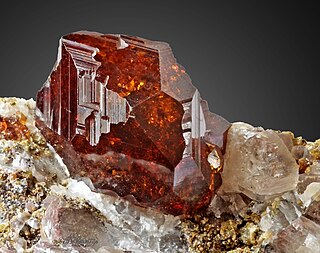
Garnets are a group of silicate minerals that have been used since the Bronze Age as gemstones and abrasives.
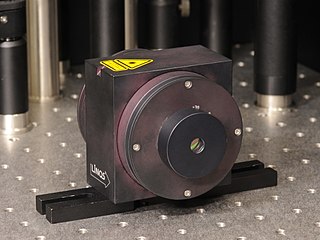
An optical isolator, or optical diode, is an optical component which allows the transmission of light in only one direction. It is typically used to prevent unwanted feedback into an optical oscillator, such as a laser cavity.
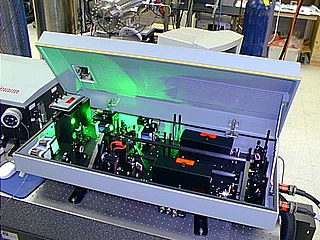
Nd:YAG (neodymium-doped yttrium aluminum garnet; Nd:Y3Al5O12) is a crystal that is used as a lasing medium for solid-state lasers. The dopant, triply ionized neodymium, Nd(III), typically replaces a small fraction (1%) of the yttrium ions in the host crystal structure of the yttrium aluminum garnet (YAG), since the two ions are of similar size. It is the neodymium ion which provides the lasing activity in the crystal, in the same fashion as red chromium ion in ruby lasers.
The Faraday effect or Faraday rotation, sometimes referred to as the magneto-optic Faraday effect (MOFE), is a physical magneto-optical phenomenon. The Faraday effect causes a polarization rotation which is proportional to the projection of the magnetic field along the direction of the light propagation. Formally, it is a special case of gyroelectromagnetism obtained when the dielectric permittivity tensor is diagonal. This effect occurs in most optically transparent dielectric materials under the influence of magnetic fields.
The Verdet constant is an optical property named after the French physicist Émile Verdet. It describes the strength of the Faraday effect for a particular material. For a constant magnetic field parallel to the path of the light, it can be calculated by:

A Faraday rotator is a polarization rotator based on the Faraday effect, a magneto-optic effect involving transmission of light through a material when a longitudinal static magnetic field is present. The state of polarization is rotated as the wave traverses the device, which is explained by a slight difference in the phase velocity between the left and right circular polarizations. Thus it is an example of circular birefringence, as is optical activity, but involves a material only having this property in the presence of a magnetic field. Circular birefringence, involving a difference in propagation between opposite circular polarizations, is distinct from linear birefringence which also transforms a wave's polarization but not through a simple rotation.
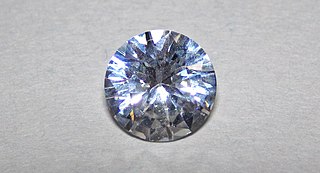
Yttrium aluminium garnet (YAG, Y3Al5O12) is a synthetic crystalline material of the garnet group. It is a cubic yttrium aluminium oxide phase, with other examples being YAlO3 (YAP) in a hexagonal or an orthorhombic, perovskite-like form, and the monoclinic Y4Al2O9 (YAM).

Lithium niobate is a non-naturally-occurring salt consisting of niobium, lithium, and oxygen. Its single crystals are an important material for optical waveguides, mobile phones, piezoelectric sensors, optical modulators and various other linear and non-linear optical applications. Lithium niobate is sometimes referred to by the brand name linobate.

Yttrium iron garnet (YIG) is a kind of synthetic garnet, with chemical composition Y3Fe2(FeO4)3, or Y3Fe5O12. It is a ferrimagnetic material with a Curie temperature of 560 K. YIG may also be known as yttrium ferrite garnet, or as iron yttrium oxide or yttrium iron oxide, the latter two names usually associated with powdered forms.

An atomic line filter (ALF) is a more effective optical band-pass filter used in the physical sciences for filtering electromagnetic radiation with precision, accuracy, and minimal signal strength loss. Atomic line filters work via the absorption or resonance lines of atomic vapors and so may also be designated an atomic resonance filter (ARF).
Lutetium aluminum garnet (commonly abbreviated LuAG, molecular formula Al5Lu3O12) is an inorganic compound with a unique crystal structure primarily known for its use in high-efficiency laser devices. LuAG is also useful in the synthesis of transparent ceramics.

Dysprosium oxide (Dy2O3) is a sesquioxide compound of the rare earth metal dysprosium. It is a pastel yellowish-greenish, slightly hygroscopic powder having specialized uses in ceramics, glass, phosphors, lasers, as a Faraday rotator and dysprosium metal halide lamps.
Chiral Photonics, Inc. is a photonics company based in Pine Brook, New Jersey, founded in 1999. The company is developing a new class of optical devices based on twisting glass optical fibers. These in-fiber devices aim to displace discrete optical elements such as lasers, filters and sensors. They benefit from optical fiber’s transmission efficiency, robustness and ease of integration.
TGG may refer to:
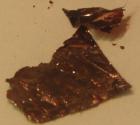
Gallium(II) selenide (GaSe) is a chemical compound. It has a hexagonal layer structure, similar to that of GaS. It is a photoconductor, a second harmonic generation crystal in nonlinear optics, and has been used as a far-infrared conversion material at 14–31 THz and above.
An optical modulator is an optical device which is used to modulate a beam of light with a perturbation device. It is a kind of transmitter to convert information to optical binary signal through optical fiber or transmission medium of optical frequency in fiber optic communication. There are several methods to manipulate this device depending on the parameter of a light beam like amplitude modulator (majority), phase modulator, polarization modulator etc. The easiest way to obtain modulation is modulation of intensity of a light by the current driving the light source. This sort of modulation is called direct modulation, as opposed to the external modulation performed by a light modulator. For this reason, light modulators are called external light modulators. According to manipulation of the properties of material modulators are divided into two groups, absorptive modulators and refractive modulators. Absorption coefficient can be manipulated by Franz-Keldysh effect, Quantum-Confined Stark Effect, excitonic absorption, or changes of free carrier concentration. Usually, if several such effects appear together, the modulator is called electro-absorptive modulator. Refractive modulators most often make use of electro-optic effect, other modulators are made with acousto-optic effect, magneto-optic effect such as Faraday and Cotton-Mouton effects. The other case of modulators is spatial light modulator (SLM) which is modified two dimensional distribution of amplitude & phase of an optical wave.

A polarization rotator is an optical device that rotates the polarization axis of a linearly polarized light beam by an angle of choice. Such devices can be based on the Faraday effect, on birefringence, or on total internal reflection. Rotators of linearly polarized light have found widespread applications in modern optics since laser beams tend to be linearly polarized and it is often necessary to rotate the original polarization to its orthogonal alternative.
Gadolinium Gallium Garnet is a synthetic crystalline material of the garnet group, with good mechanical, thermal, and optical properties. It is typically colorless. It has a cubic lattice, a density of 7.08 g/cm3 and its Mohs hardness is variously noted as 6.5 and 7.5. Its crystals are produced with the Czochralski method. During production, various dopants can be added for colour modification. The material is also used in fabrication of various optical components and as a substrate material for magneto–optical films. It also finds use in jewelry as a diamond simulant. GGG can also be used as a seed substrate for the growth of other garnets such as YIG.

Cerium(III) fluoride (or cerium trifluoride), CeF3, is an ionic compound of the rare earth metal cerium and fluorine.
References
- ↑ "Terbium Gallium Garnet - TGG" (PDF). Northrop Grumman. 2011.
- ↑ Hassaan Majeed; Amrozia Shaheen & Muhammad Sabieh Anwar (2013). "Complete Stokes polarimetry of magneto-optical Faraday effect in a terbium gallium garnet crystal at cryogenic temperatures". Optics Express. Optics InfoBase. 21 (21): 25148–58. Bibcode:2013OExpr..2125148M. doi: 10.1364/OE.21.025148 . PMID 24150356.
- ↑ Vojna, David; Slezák, Ondřej; Lucianetti, Antonio; Mocek, Tomáš (2019). "Verdet Constant of Magneto-Active Materials Developed for High-Power Faraday Devices". Applied Sciences. 9 (15): 3160. doi: 10.3390/app9153160 .
- ↑ Vojna, David; Duda, Martin; Yasuhara, Ryo; Slezák, Ondřej; Schlichting, Wolfgang; Stevens, Kevin; Chen, Hengjun; Lucianetti, Antonio; Mocek, Tomáš (2020). "Verdet constant of potassium terbium fluoride crystal as a function of wavelength and temperature". Opt. Lett. 45 (7): 1683–1686. Bibcode:2020OptL...45.1683V. doi:10.1364/ol.387911. PMID 32235973.
- ↑ "Optical Isolator Tutorial (Page 1 of 2)" (PDF). SeongKyeong Photonics / Thorlabs.